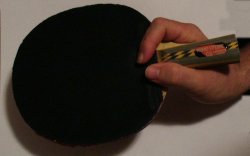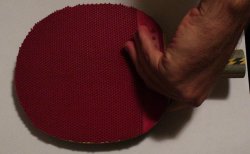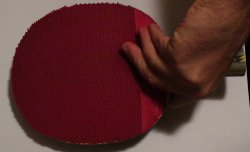
In the reverse penhold backhand grip, the back of the penhold bat is used to hit the backhand. Typically the fingers are held in a similar fashion to the traditional Chinese penhold grip.
It is most common to put inverted rubber on the backhand, and use the backhand to produce a topspin ball which has a significant amount of left to right sidespin (for a right hander), due to the natural movement of the arm and racket.
Advantages
On the forehand side, this grip is similar to the traditional Chinese penhold grip. On the backhand side, the use of the rpb grip removes the normal weakness of the Chinese penhold grip since it is able to produce a heavy topspin ball with good power and a wide reach. It is also very good at attacking short balls on the backhand due to flexible wrist movement. Some players will use a mixture of the rpb grip and the Chinese penhold block and push on the backhand side to give more variation.

Disadvantages
If the rpb grip is used exclusively from the backhand side, it suffers from the same problems as the shakehand grip, in that the player will have a crossover point, or an ‘area of indecision’, where the ball cannot be easily struck with the forehand or backhand side, and a decision to use one or the other stroke must be made.
If the rpb grip is mixed with the Chinese penhold push and block strokes, the problem that occurs is that the player must decide quickly which type of stroke to use, and adjust the bat accordingly.
Another limitation of the rpb grip is that it is actually quite difficult to produce a topspin ball from the backhand side that does not have sidespin, and hitting down the line from the backhand side is more difficult than hitting crosscourt.
What Type of Player Uses this Grip?

This grip is currently being used by attacking style players who prefer to play with heavy topspin on both sides. As a relatively new grip, it remains to be seen whether its use for other styles will become popular.

